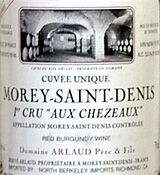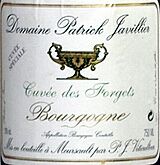|
Introducing Burgundy: Morey-Saint-Denis
Does proximity matter when it comes to seeking value in the world of Burgundy? It certainly helps market a wine when the producer can boast that his vineyards lie close by a more noteworthy property. Whether this relates directly to wine quality is more of a guessing game, particularly in Burgundy where you'll often find real differences between wines from adjacent vineyards differentiated only by minuscule differences in slope, direction, soil geology and the other subtle variations in environment that make up collectively what the French call terroir, the effect of the land on wine. Today's excursion into the world of Burgundy illustrates this principle as we go back to the Côte de Nuits, the northern portion of the Côte d'Or, that east-facing, 30-mile limestone escarpment around Beaune that produces some of the world's most sought-after wines.
Our destination is Morey-Saint-Denis, a block of vineyards surrounding the little village of that name, neatly sandwiched between two other villages whose wines are somewhat better-known: Gevrey-Chambertin to the north and Chambolle-Musigny to the south. Gevrey, the stereotypical conventional wisdom goes, produces wines of body and power, while Chambolle makes wines of delicacy and finesse. Morey? Well, in the bottle as on the map, it's sort of in-between. You can view a map of the Côte de Nuits under "Vineyards" on the BIVB Website referenced in last Friday's edition, or go directly to the map image, Of course, wine is better judged in the glass than on the grapevine, and even the most tradition-bound experts agree that there's plenty of excellent wine in Morey-Saint-Denis. If the village's slightly less burnished reputation means you can sometimes save a few dollars on a good one, there's nothing wrong with that. In his weighty book "Burgundy," the critic Robert M. Parker Jr. observes that the village Morey-Saint-Denis - like so much of Burgundy - was once in the hands of the Church, originally belonging to the powerful Abbey Citeaux. The village burned to the ground in the late seventeenth century and, Parker says, "afterwards suffered from plagues and as a haven for misfits and beggars." Perhaps this helps explain its diminished reputation, although he goes on to note that after World War II Morey "began to experience a degree of prosperity and become fully populated." Typical of the Côte de Nuits, the map of Morey-Saint-Denis looks a bit like a rugby shirt, with three broad, even stripes running north and south. The westernmost stripe, highest on the slope, contains its Grand Cru vineyards, which include such well-known names as Bonnes Marres, Clos de la Roche and Clos de Tart. The eastern band, lowest on the slope and occupying flattish land along the highway from Beaune to Dijon, contains the unclassified vineyards. The middle ground, in elevation and in reputation, houses most of Morey's Premier Cru vineyards, including the source of today's featured wine, Aux Chezeaux. This small vineyard lies on the village's northern border, directly adjacent to Gevrey-Chambertin and abutting Gevrey's Grand Cru vineyard Mazoyères du Charmes, a proximity that the importer is not loath to point out. As I said at the beginning of today's dissertation, proximity is everything in Burgundy, at least where marketing is concerned. This wine, however, speaks for itself: Rich, fruity, yet structured and tart, with just a touch of the barnyard to say "Burgundy" without shouting, it was an excellent example of Morey with plenty of character, a clear demonstration of Burgundy's seductive appeal. I also feature a bonus wine today, one of the lower-end (but still appealing) Burgundies that I had overlooked in my earlier investigation of the mixed case of 12 intriguing items that I bought last month from California's North Berkeley Imports. A white Burgundy bearing only the most generic appellation, "Bourgogne," it's made by a producer based in Meursault. While the broad appellation makes no guarantees about the specific source of its fruit within Burgundy, it's easy to imagine that Meursault somehow infused a whiff of its spirit in this rich yet structured Chardonnay.
JOIN ME IN BURGUNDY IN MAY
BURGUNDY EXPERTISE
TALK ABOUT BURGUNDY ONLINE If you prefer to comment privately, feel free to send me E-mail at wine@wineloverspage.com. I'm sorry that the overwhelming amount of mail I receive makes it tough to respond personally every time, but I do try to get back to as many as I can.  Domaine Hervé Arlaud 1999 Morey-Saint-Denis Ier Cru "Aux Chezeaux" ($25)
Domaine Hervé Arlaud 1999 Morey-Saint-Denis Ier Cru "Aux Chezeaux" ($25)
Dark garnet in color, rich purple at the edge, this unfiltered bottling produced specifically for North Berkeley ("Cuvee Unique") breathes ripe black plums and a distinct note of the earthy "barnyard" quality that's often, though not always, a signature of red Burgundy, accented with hints of brown spice. Flavors follow the nose, juicy fruit shaped by tart, lemon-squirt acidity. Tannins are not immediately apparent, and a beatiful tart-sweet pomegranate flavor emerges in the lingering finish. U. S. importer: North Berkeley Imports, Berkeley, Calif. (Jan. 18, 2004) FOOD MATCH: Just right with the simple, gently piquant Burgundian pork-chop dish featured in yesterday's Wine Advisor FoodLetter, Mireille Johnston's Côtes de Porc au Vinaigre. VALUE: It was a great value in December's half-price sale; persuasive even at its full-retail $49.95. WHEN TO DRINK: Note that this 1999 vintage is three years behind the current release, which may explain the sale price. Nevertheless, it's drinking beautifully now, and its structure and balance suggest that it would not suffer from another five years under good cellar conditions.
WEB LINK: The importer offers information about Hervé Arlaud's more recent releases in its November 2003 newsletter online:
FIND THIS WINE ONLINE: Find Moreys from Arlaud on Wine-Searcher.com:  Domaine Patrick Javillier 2001 "Cuvee des Forgets" Bourgogne ($12)
Domaine Patrick Javillier 2001 "Cuvee des Forgets" Bourgogne ($12)
This is a clear, straw-color wine with a slight golden hue. Fresh apple aromas are enhanced with a whiff of spice, with luscious scents of apples, pears and peaches coming up when you swirl the wine in the glass. The aromas predict the full, ripe pear and apple flavors, clean and juicy white fruit, full-bodied but nicely framed with snappy acidity. Rises far above expectations for generic white Bourgogne. U. S. importer: North Berkeley Imports, Berkeley, Calif. (Jan. 18, 2004) FOOD MATCH: A simple dinner of pork chops sauteed with onions made a perfect match. (Note, in passing, that pork dishes tend to go well with both white Burgundy and red.) VALUE: Can't be beat for value at North Berkeley's December sale price, more spendy, but still more than competitive with high-end Chardonnays of similar quality at the full-retail $23.95. WHEN TO DRINK: It's hard to imagine not slurping the delicious wine now, but the sturdy structure under all that fruit might make it an interesting experiment for a few years if you have good storage conditions, hoping to discover the glories of richness and complexity that can come with older white Burgundies if your luck runs well.
WEB LINK: You'll find links to tasting reports on Javillier's 1999 and 2000 white Burgundies on North Berkeley's Website at
FIND THIS WINE ONLINE: To compare prices and find vendors for Patrick Javillier's Burgundies, browse the Wine-Searcher.com database: Thanks, and a quick progress report on our premium edition As always when I ask your opinions on the Wine Advisor and planned new features, I'm touched and gratified by the thoughtfulness, and the sheer numbers, of your responses. So it is with your replies to my note in Wednesday's edition. More than 300 of you have already responded to my request for your thoughts about a possible additional publication in the Wine Advisor series. As I wrote Wednesday, this would be an occasional mailing about somewhat more expensive wines in the price range that many of us consider appropriate for special occasions. Similar in form and content to your daily Wine Advisor, differing mostly in the price range of wines reviewed and a consistent focus on consumer-oriented buying advice, it would be E-mailed monthly or bimonthly at first, available exclusively on a paid-subscription basis. This would be a trustworthy consumer guide to exceptionally good buys in the "next tier" of $30 to $100 price range (mostly under $60), based entirely on wines I purchase at my own expense (no winery "freebies"), chosen from all the world's wine regions with preference to wines available in most major metropolitan areas around the world. Like your daily Wine Advisor, it would feature thorough, objective and tell-it-as-it-is reports on the selected wines, including both analytical reports and discussions as to how they go with specific dishes and general food matches, ageworthiness and when-to-drink recommendations, value ratings, Web links, historical and geographical information about the wines, and as much information as I can gather to help you find the wines in your own community or online. By "passing the hat" in the form of a modest subscription rate for this publication only, I would generate the income necessary to buy these wines, and, with any luck, bring in a little extra to help pay the rent that keeps all our other publications free. I'm planning an annual subscription rate of $24 per year, about the price of just one bottle of upscale wine, which works out to no more than $1 each for an absolute minimum of two comprehensive wine reports per month, but likely more. Most of you who have responded agree that this would be a modest price to pay for the assurance that will allow you to purchase these wines from your own sources in confidence that your money isn't being wasted. After all, it's great to have tips on a $10 bottle that tastes like it's worth more; but when a $30 or even a $75 investment is in the offing, that's when many of us really want advice we can trust. Based on the responses I have received, I expect to move forward promptly with the new edition, and hope to have it ready to announce this coming week week. Needless to say, this new feature will be in addition to, not in place of, all the wine information that I currently provide for free. The weekly and daily Wine Advisor and Thursday FoodLetter will continue exactly as before. I'm making every effort to respond to every note I receive on this, although with the numbers growing, I'm falling behind, and it may take the weekend to get back to you all. I appreciate all your notes, not only from the many of you who say you're eager to sign on, but also from those who don't see this one as being for you but were kind enough to offer me your opinions all the same. If you haven't chimed in yet but have a comment or opinion that you would like to share, you're still more than welcome to write me directly at wine@wineloverspage.com. Again, I'll try to pay you all the respect of a personal reply, although thanks to your generous responses, it may take a few days to catch up. Administrivia To subscribe or unsubscribe from The 30 Second Wine Advisor, change your E-mail address, or for any other administrative matters, please use the individualized hotlink found at the end of your E-mail edition. If this is not practical, contact me by E-mail at wine@wineloverspage.com, including the exact E-mail address that you used when you subscribed, so I can find your record. We do not use our E-mail list for any other purpose and will never give or sell your name or E-mail address to anyone. I welcome feedback, suggestions, and ideas for future columns. To contact me, please send E-mail to wine@wineloverspage.com All the wine-tasting reports posted here are consumer-oriented. In order to maintain objectivity and avoid conflicts of interest, I purchase all the wines I rate at my own expense in retail stores and accept no samples, gifts or other gratuities from the wine industry.
Friday, Jan. 30, 2004 |





